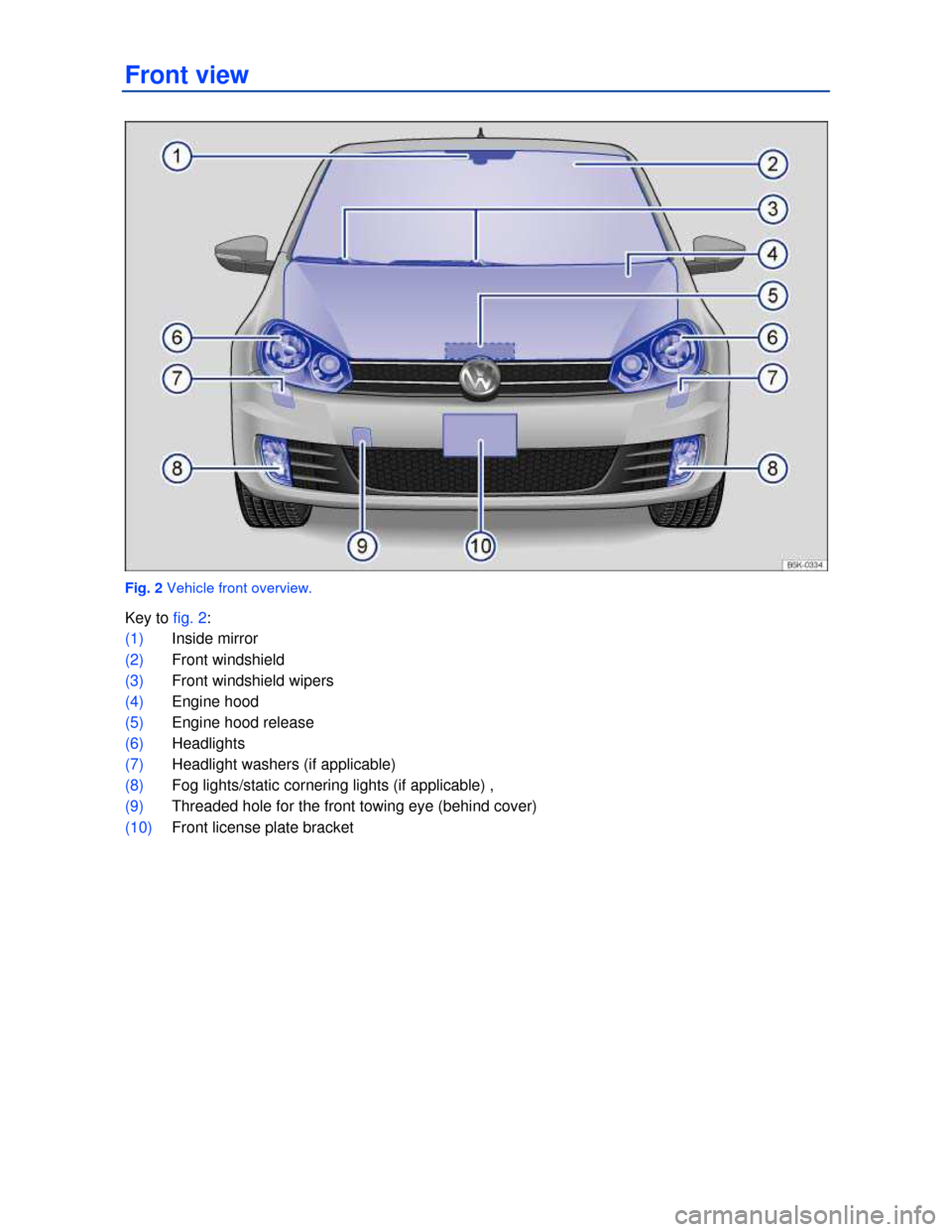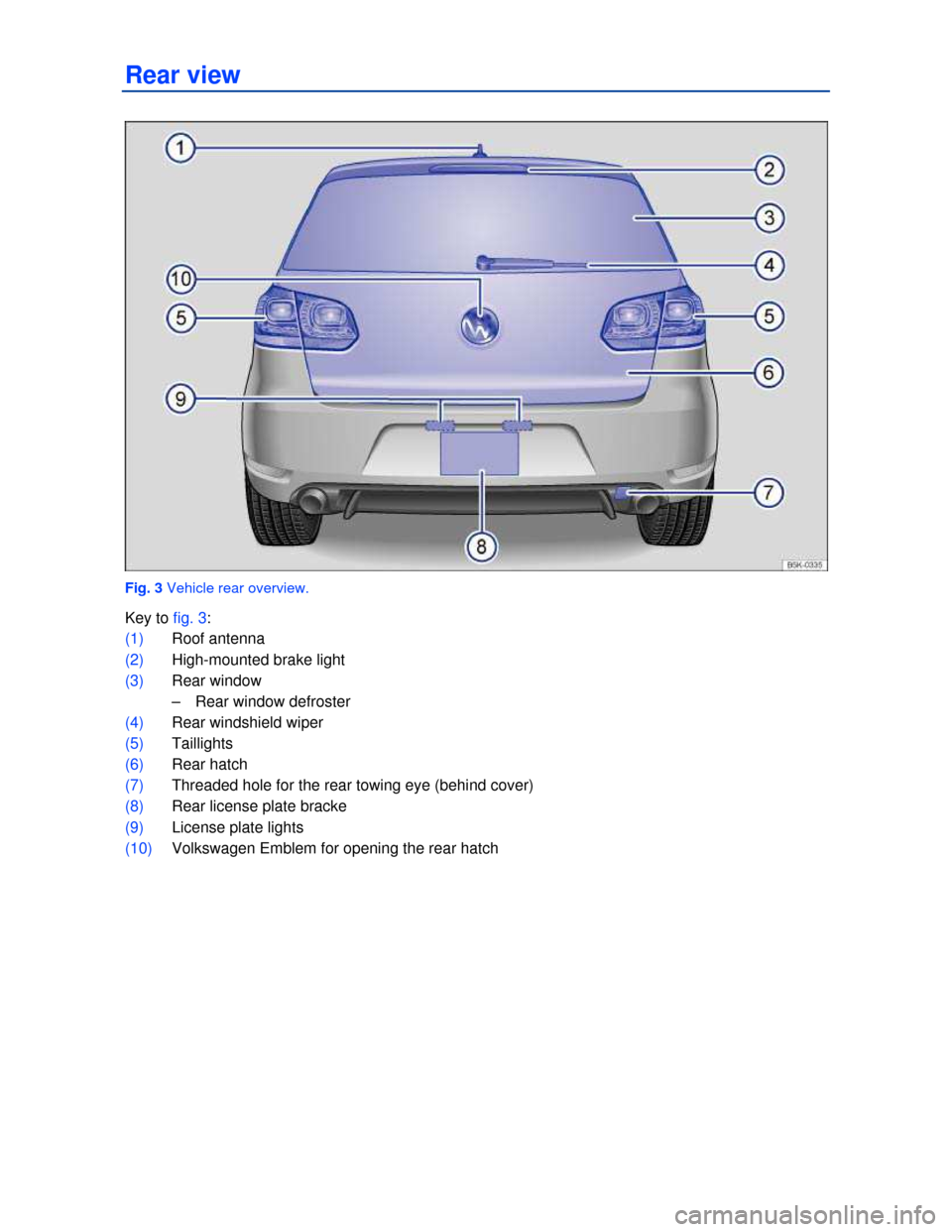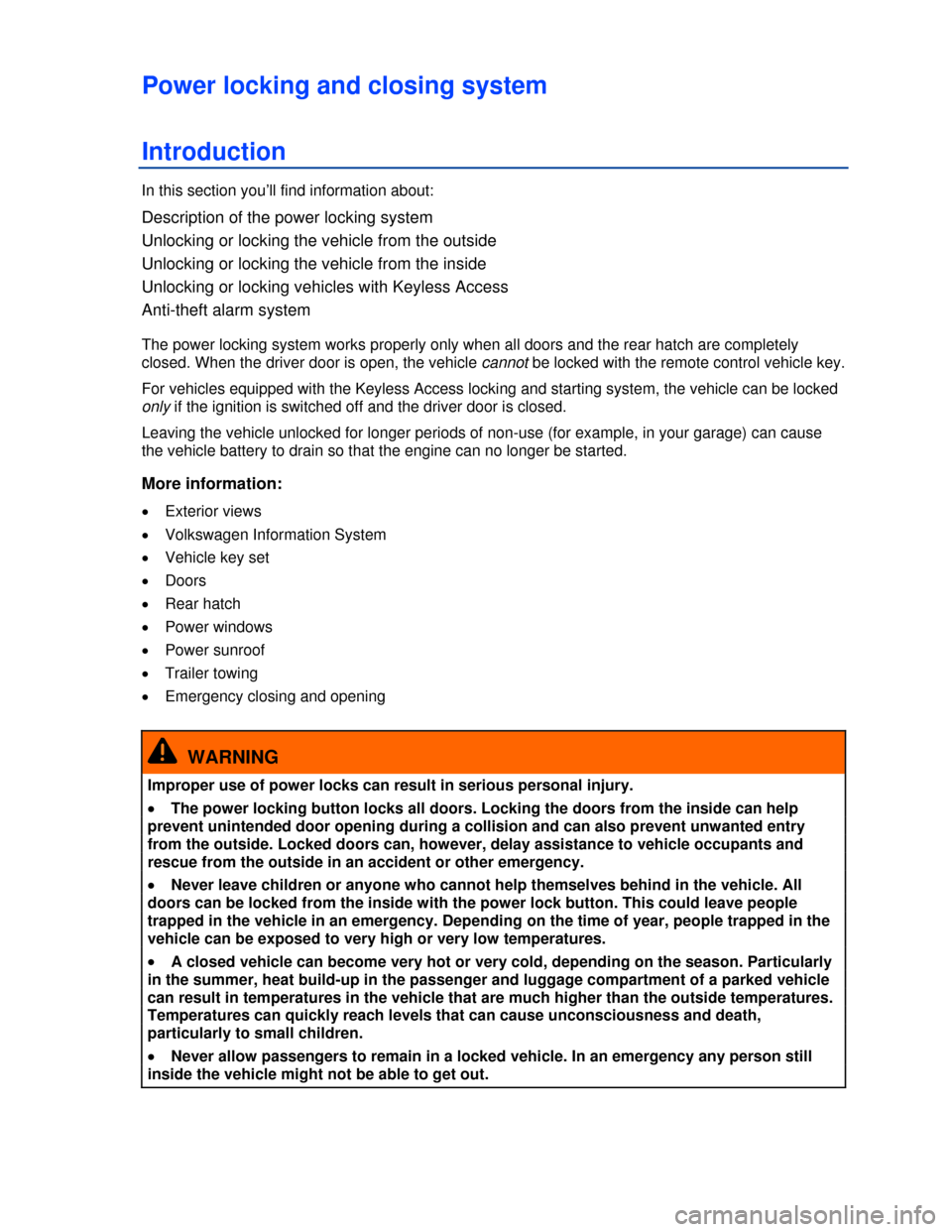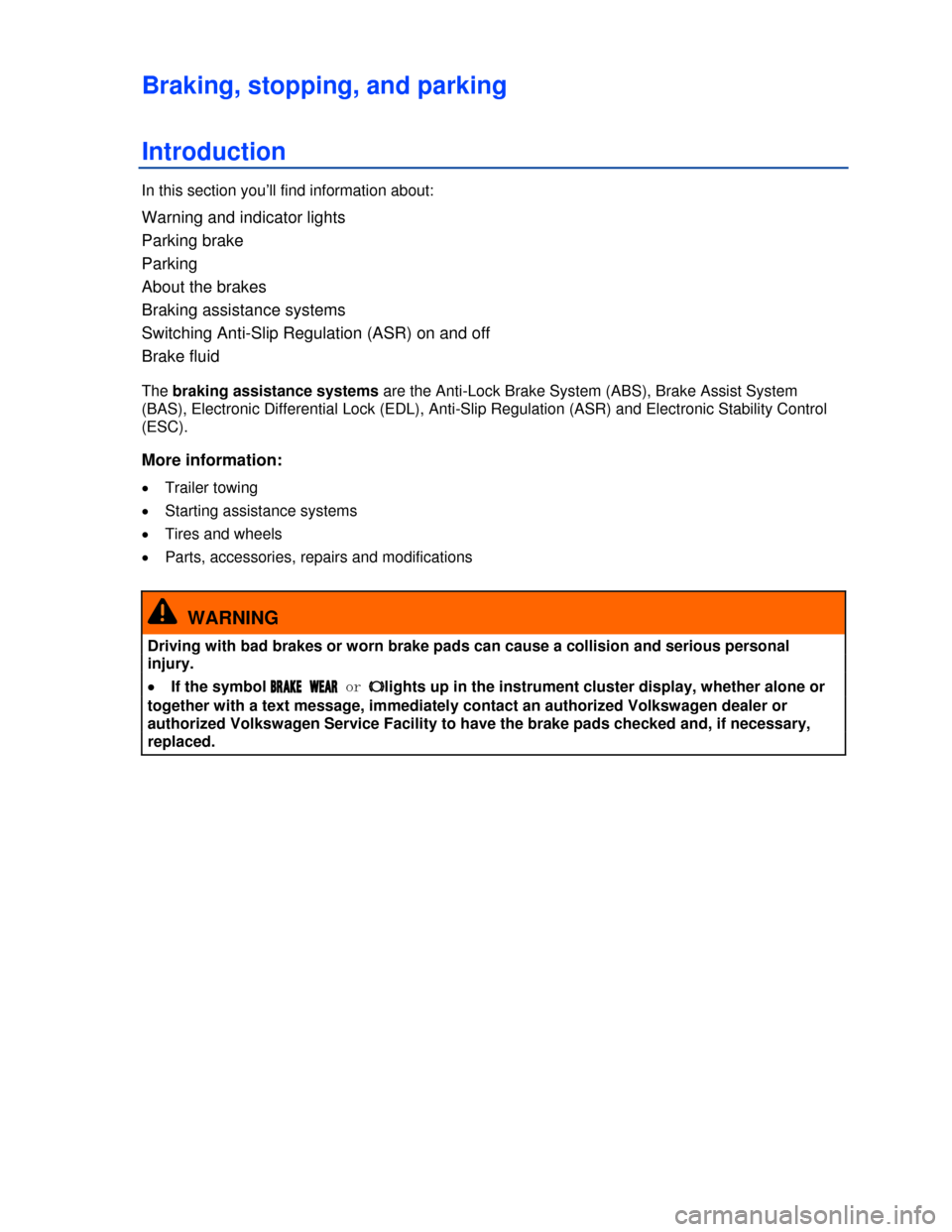2013 VOLKSWAGEN GOLF GTI towing
[x] Cancel search: towingPage 2 of 319

Front view
Fig. 2 Vehicle front overview.
Key to fig. 2:
(1) Inside mirror
(2) Front windshield
(3) Front windshield wipers
(4) Engine hood
(5) Engine hood release
(6) Headlights
(7) Headlight washers (if applicable)
(8) Fog lights/static cornering lights (if applicable) ,
(9) Threaded hole for the front towing eye (behind cover)
(10) Front license plate bracket
Page 3 of 319

Rear view
Fig. 3 Vehicle rear overview.
Key to fig. 3:
(1) Roof antenna
(2) High-mounted brake light
(3) Rear window
– Rear window defroster
(4) Rear windshield wiper
(5) Taillights
(6) Rear hatch
(7) Threaded hole for the rear towing eye (behind cover)
(8) Rear license plate bracke
(9) License plate lights
(10) Volkswagen Emblem for opening the rear hatch
Page 28 of 319

¥ Properly fasten your safety belt before driving the vehicle and wear your safety belt properly at all
times while driving. Make sure that all passengers do the same
¥ Only transport as many passengers as there are seats and safety belts available.
¥ Never drive if your driving ability has been impaired, for example by medication, alcohol or illegal
drugs.
¥ Never let passengers or phone calls distract you while driving, and never take your attention off the
road while using vehicle software or adjusting vehicle equipment or accessories.
¥ Always adapt your speed and driving style to visibility, weather, road, and traffic conditions.
¥ Always obey traffic laws and speed limits.
¥ On long trips make frequent rest stops – at least once every 2 hours.
¥ Secure animals in the vehicle with a system that corresponds to weight and size.
WARNING
Always observe traffic rules and posted speed limits and use common sense. Your good
judgment can mean the difference between arriving safely at your destination and being seri-
ously injured in a crash or other kind of accident.
Regular service and maintenance of your vehicle is important both for operational and driving
safety and to help prolong your vehicle's service life. Always follow the scheduled maintenance inter-
vals in the ⇒ Booklet Warranty and Maintenance, especially for changing the brake fluid. Hard use,
frequent stop-and-go driving, driving in very dusty areas, trailer towing, and other factors may make it
necessary to have the vehicle serviced more frequently. Ask an authorized Volkswagen dealer or an
authorized Volkswagen Service Facility for more information.
Driving in other countries
�
Page 38 of 319

Power locking and closing system
Introduction
In this section you’ll find information about:
Description of the power locking system
Unlocking or locking the vehicle from the outside
Unlocking or locking the vehicle from the inside
Unlocking or locking vehicles with Keyless Access
Anti-theft alarm system
The power locking system works properly only when all doors and the rear hatch are completely
closed. When the driver door is open, the vehicle cannot be locked with the remote control vehicle key.
For vehicles equipped with the Keyless Access locking and starting system, the vehicle can be locked
only if the ignition is switched off and the driver door is closed.
Leaving the vehicle unlocked for longer periods of non-use (for example, in your garage) can cause
the vehicle battery to drain so that the engine can no longer be started.
More information:
�x Exterior views
�x Volkswagen Information System
�x Vehicle key set
�x Doors
�x Rear hatch
�x Power windows
�x Power sunroof
�x Trailer towing
�x Emergency closing and opening
WARNING
Improper use of power locks can result in serious personal injury.
�x The power locking button locks all doors. Locking the doors from the inside can help
prevent unintended door opening during a collision and can also prevent unwanted entry
from the outside. Locked doors can, however, delay assistance to vehicle occupants and
rescue from the outside in an accident or other emergency.
�x Never leave children or anyone who cannot help themselves behind in the vehicle. All
doors can be locked from the inside with the power lock button. This could leave people
trapped in the vehicle in an emergency. Depending on the time of year, people trapped in the
vehicle can be exposed to very high or very low temperatures.
�x A closed vehicle can become very hot or very cold, depending on the season. Particularly
in the summer, heat build-up in the passenger and luggage compartment of a parked vehicle
can result in temperatures in the vehicle that are much higher than the outside temperatures.
Temperatures can quickly reach levels that can cause unconsciousness and death,
particularly to small children.
�x Never allow passengers to remain in a locked vehicle. In an emergency any person still
inside the vehicle might not be able to get out.
Page 108 of 319

Braking, stopping, and parking
Introduction
In this section you’ll find information about:
Warning and indicator lights
Parking brake
Parking
About the brakes
Braking assistance systems
Switching Anti-Slip Regulation (ASR) on and off
Brake fluid
The braking assistance systems are the Anti-Lock Brake System (ABS), Brake Assist System
(BAS), Electronic Differential Lock (EDL), Anti-Slip Regulation (ASR) and Electronic Stability Control
(ESC).
More information:
�x Trailer towing
�x Starting assistance systems
�x Tires and wheels
�x Parts, accessories, repairs and modifications
WARNING
Driving with bad brakes or worn brake pads can cause a collision and serious personal
injury.
�x If the symbol �"�2�!�+�% �7�%�!�2 or �Ilights up in the instrument cluster display, whether alone or
together with a text message, immediately contact an authorized Volkswagen dealer or
authorized Volkswagen Service Facility to have the brake pads checked and, if necessary,
replaced.
Page 116 of 319

slush or snow, ESC cannot perform the same way it would on a dry surface. If the vehicle
“hydroplanes” (rides on a cushion of water instead of the road surface), ESC will not be able to help
you steer the vehicle because contact with the pavement has been interrupted and the vehicle cannot
be braked or steered. During fast cornering, particularly on winding roads, ESC cannot always deal as
effectively with difficult driving situations as it can at lower speeds. When towing a trailer, ESC is not
able to help you regain control as it would if you were not towing a trailer.
Always adjust your speed and driving style to visibility, road, traffic, and weather conditions. ESC
cannot override the vehicle's physical limits, increase the available traction, or keep a vehicle on the
road if road departure is a result of driver inattention. Instead, ESC improves the possibility of keeping
the vehicle under control and on the road during extreme maneuvers by using the driver's steering
inputs to help keep the vehicle going in the intended direction. If you are traveling at a speed that
causes you to run off the road before ESC can provide any assistance, you may not experience the
benefits of ESC.
ESC includes and/or works together with the ABS, BAS, ASR, EDL, and XDL systems (see below).
ESC is switched on all the time. In certain situations when you need less traction or additional traction
cannot be achieved, you can switch off ASR by pressing the �m button ⇒ fig. 133. Be sure to switch
ASR on again when you no longer need less traction.
Anti-Lock Brake System (ABS)
ABS helps to keep the wheels from locking up and helps to maintain the driver's ability to steer and
control the vehicle. This means the vehicle is less likely to skid, even during hard braking:
�x Push the brake pedal down hard and hold it there. Don't take your foot off the pedal or reduce the
force on the pedal!
�x Do not “pump” the brake pedal or let up on it!
�x Steer the vehicle while pushing down hard on the brake pedal.
�x ABS stops working if you release or let up on the brake.
When ABS is doing its job, you will notice a slight vibration through the brake pedal and hear a
noise. ABS cannot shorten the stopping distance under all conditions. The stopping distance may
even be longer, for instance, when driving on gravel or on newly fallen snow covering an icy or
slippery surface.
Brake Assist (BAS)
The Brake Assist System can help to reduce stopping distances. If you press the brake pedal very
quickly, BAS detects an emergency situation. It then very quickly builds up full brake system pressure,
maximizing braking power and reducing the stopping distance. This way, ABS can be activated more
quickly and efficiently.
Do not reduce pressure on the brake pedal! BAS switches off automatically as soon as you release or
let up on the brake.
Anti-Slip Regulation (ASR)
ASR reduces engine power directed to spinning wheels and adjusts power to the road conditions.
Even under poor road conditions, ASR can make it easier to get moving, accelerate, and climb hills.
ASR can be switched on or off manually
Electronic Differential Lock (EDL and XDL)
EDL is applied during regular straight-line acceleration. EDL gently brakes a drive wheel that has lost
traction (spinning) and redirects the drive force to other drive wheels. In extreme cases, EDL
automatically switches off to keep the brake from overheating. As soon as the brake has cooled down,
EDL automatically switches on again.
XDL is an extension of the Electronic Differential Lock system. XDL does not react to drive wheel
slippage when driving straight ahead. Instead, XDL detects slippage of the inside front wheel during
fast cornering. XDL applies enough brake pressure to this wheel in order to stop the slippage. This
improves traction, which helps the vehicle stay on track.
Page 136 of 319

Driving tips
Introduction
In this section you’ll find information about:
Stowing luggage
Driving with an open rear hatch
Driving a loaded vehicle
Weights and axle weights
Always stow heavy objects in the luggage compartment and make sure that the rear seat backrests
are securely latched. Always use the tie-downs in the luggage compartment and secure the objects
with suitable straps. Never overload the vehicle. Remember that the vehicle load, as well as how it is
distributed, can affect vehicle handling and braking ⇒ .
More information:
�x Rear hatch
�x Folding the passenger seat backrest forward
�x Lights
�x Luggage compartment
�x Roof rack
�x Trailer towing
�x Tires and wheels
WARNING
Unsecured or incorrectly stowed items can fly through the vehicle, causing serious personal
injury during hard braking or sharp steering or in an accident. Loose items can also be struck
and thrown through the passenger compartment by the front airbags if they inflate. To help
reduce the risk of serious personal injury:
�x Always stow all objects securely in the vehicle.
�x Always keep storage compartments closed while driving.
�x Do not stow hard, heavy, or sharp objects in open bins in the vehicle or on top of the
instrument panel.
�x Remove hard, heavy, and sharp objects from clothing and bags in the vehicle interior and
stow securely. Always put heavy items in the luggage compartment.
�x Always secure objects in the passenger compartment properly with suitable straps so that
they cannot move into the deployment area of a side or front airbag during braking, in a
sudden maneuver, or in a collision.
�x Always make sure that there is nothing on the front passenger seat when the backrest is
folded forward. When the backrest is folded forward, even light objects could be pushed into
the seat cushion and cause the weight-sensing mat in the seat to register enough weight to
turn the airbag on
�x Always make sure that the PASSENGER AIR BAG OFF 9 light is on and stays on whenever
the backrest of the front passenger seat is folded forward
�x Passengers must never ride in an incorrect seating position because objects are being
transported in the vehicle.
�x Never let anybody sit in a seat that is blocked by objects being carried in the vehicle.
Page 137 of 319

WARNING
Heavy loads will influence the way your vehicle handles and increase stopping distances.
Heavy loads that are not properly stowed or secured can cause loss of control and serious
injury.
�x Secure the load properly to keep it from shifting.
�x Always remember when transporting heavy objects that a change in the center of gravity
also changes the way your vehicle handles:
– Always distribute the load as evenly as possible.
– Secure heavy objects properly as far forward in the luggage compartment as possible.
– Always tie down heavy items securely with suitable straps using the tie-downs in the
luggage compartment.
�x Securely latch the rear seat backrest in the upright position.
�x Never exceed the Gross Axle Weight Rating or the Gross Vehicle Weight Rating on the
safety compliance sticker on the left door jamb. Exceeding permissible weight can cause the
vehicle to skid and handle differently.
�x Always adapt your speed and driving to the heavier load and the weight distribution in the
vehicle. Take road, weather, traffic, and visibility conditions into account as well.
�x Always accelerate gently and avoid sudden braking and driving maneuvers.
�x Always brake earlier than you would if you were not driving a loaded vehicle.
Stowing luggage
�